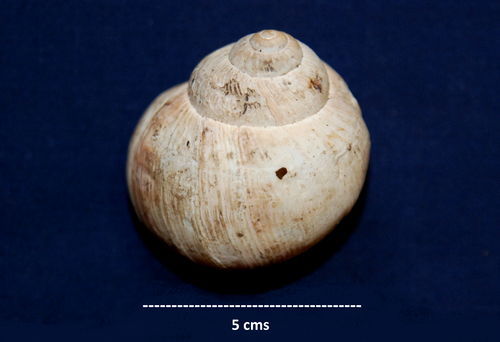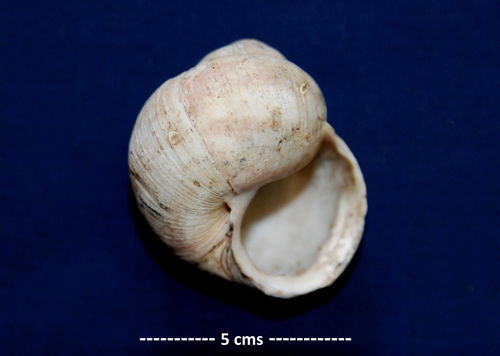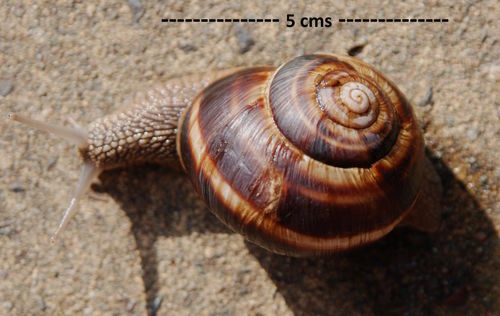Helix pomatia L., 1758 and Helix lucorum L., 1758 (Pulmonata, Helicidae): two closely related terrestrial snails new to Worcestershire.
P.F. Whitehead, Moor Leys, Little Comberton, Pershore, Worcestershire WR10 3EH Email: paul@thewhiteheads.eu
Introduction
Until 2007 Helix pomatia L., 1758, for long termed the ‘Roman Snail’, was the largest terrestrial gastropod known to occur in Britain; in mainland Europe it is a widespread calciphilous species attaining altitudes of 2000 metres in the Alps. In Britain its distribution is centred on the Jurassic escarpment and Chiltern Hills but a clear understanding of its present and historical status is rather limited and obscure (JNCC, 2007). Ellis (1926) provides useful background data for H. pomatia. It prefers friable sediments often on the exposed margins of limestone scrub or rank scrubby calcareous grassland on steep slopes such as those of the north Cotswold escarpment. In the high Julian Alps the author has observed H. pomatia in diffusely broken woodland edges and ecotones between woodland and herb-dominated biozones. Helix pomatia is intolerant of modern land cultivation methods due in part to an extended winter resting period below ground. The name ‘Roman Snail’ derives from its management in Roman times in specially constructed Cochlearia and its established occurrence in archaeological contexts of that age.
Helix lucorum L., 1758 the so-called ‘Turkish Snail’ has recently been imported into western Europe in such large numbers that its populations in Turkey have been significantly reduced. It is now naturalised on the outskirts of Paris (Mienis & Rittner, 2010) and since 2012 has been found naturalised in England in the Home Counties and more recently as far north as Lancashire (http://www.conchsoc.org/sites/default/files/MolluscWorld/AGM%20Apr%202013/NonMarineRecorder2012.pdf). Helix lucorum is more thermophilous than H. pomatia extending around the Mediterranean and Black Sea coasts and also further to the east. In Dobruja the author has observed H. lucorum in numbers around the fringes and draw-down zones of brackish coastal lakes, a habitat distinct from those occupied by H. pomatia.
Discussion
During March 2014 I overviewed archaeological items that originated from Bredon Hill in the parish of Beckford (SO93 just within VC33 East Gloucestershire). The material contained evidence of only one invertebrate namely the shell of a ‘Roman Snail’ Helix pomatia (01 and 02). As H. pomatia is presently unknown on Bredon Hill and in administrative Worcestershire this is a significant record but one which I ascribe to the Romanised occupation of Bredon Hill. This does not mean that the species then, about AD250, was not naturalised but enough is known of the immediate settlement to confirm that its inhabitants were highly sophisticated and perfectly capable of managing Cochlearia. I am unaware of records of H. pomatia from any of the Cotswold Hill outliers but populations from the north Cotswold escarpment may have similar historical pedigrees. The date of discovery of this specimen cannot be confirmed but from what is known a ‘mean’ working date of ‘15 June 1964’ is a broadly realistic indication only.
An example of Helix lucorum passed to me for identification by Mr J. W. Meiklejohn (03) predates the earliest published British record of this species by five years and is therefore also a Worcestershire novelty. It was found on 6th October 2007 by Mr Mervyn Needham at St Peter’s Garden Centre on the Worcester conurbation fringe (52o16'N 2o19'W SO867513); I have no knowledge of other specimens from this site. For invertebrates actively extending their ranges through human activity in conjunction with climatic change, garden centres provide ideal staging posts, particularly through the distribution of their eggs in horticultural compost.
Pictures
01. Helix pomatia L. Roman archaeological context, Bredon Hill, Beckford, Worcestershire (VC 33 SO 93) ‘15 June 1964’ this date being indicative only. © P. F. Whitehead: 21 March 2014.
02. Helix pomatia L. Roman archaeological context, Bredon Hill, Beckford, Worcestershire (VC 33 SO 93) ‘15 June 1964’. The faint brown spiral bands are still discernible on the shell. © P. F. Whitehead: 21 March 2014.
03. Helix lucorum L. St Peter’s Garden Centre, Worcester, 6 October 2007. Note the broad brown spiral bands on the shell with strongly contrasting paler bands and some evidence of diffuse darker radial bands. © P.F. Whitehead
Conclusion
Two large terrestrial gastropods, H. lucorum and H. pomatia, are here recorded new to Worcestershire. The origin of both can be ascribed to human intervention during two discrete time periods circa 1800 years apart. It is unnecessary to presume that this shell of H. pomatia survived on a land surface for that long; more probably it remained below ground for the greater part of the time. It seems to me, given their known and changing biogeography, that the vernacular names of these molluscs as used here, are, rather like ‘London Plane’, somewhat unhelpful.
Acknowledgements
I wish to extend thanks to Mrs Tonia Byrd, the Vale of Evesham Historical Society, Evesham Town Council, Mr Mervyn Needham and Mr John Meiklejohn for their contribution to this output.
References
Ellis, A.E., 1926. British snails. Clarendon Press, Oxford. pp. 1-275, plates i-xiv.
Joint Nature Conservation Committee, 2007. Second Report by the UK under Article 17 on the implementation of the Habitats Directive from January 2001 to December 2006. Peterborough: JNCC.
Mienis, H. K. & Rittner, O., 2010. On the presence of Helix lucorum Linnaeus, 1758 (Mollusca, Gastropoda, Helicidae) in Le Vesinet, a western suburb of Paris. Journal électronique de la malacologie continentale française 6: 266-267. (ISSN 1778-3941).
Images
01. Helix pomatia L. Beckford, Worcestershire
02. Helix pomatia L. Beckford, Worcestershire
03. Helix lucorum St Peter’s Garden Centre, Worcester


